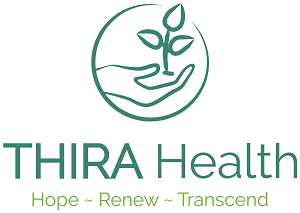
Editor's note: This article was sponsored by THIRA Health.
Chances are, you’re familiar with the saying “New year, new you.” It’s a mantra that many Americans embrace every year when they set New Year’s resolutions. When it comes to deciding on goals at the start of a new year, it’s easy to set our sights high, but going from 0 to 100 isn’t sustainable over the long term. (That’s probably why so few of us actually achieve our New Year’s resolutions.) Instead of shooting for the stars, we should focus on adherence, setting realistic goals that we can put into practice easily.
What’s more, it may be time to reframe our resolutions altogether. In 2021, Americans’ top three resolutions were exercising more, improving their diet and losing weight. And while these goals may be considered healthy ones, experts say there is much more to be considered in our quest for wellness. ParentMap spoke with registered dietitians Bailee Rice, Sami Kingry and Shawn Zajicek of THIRA Health to find out what it really means to be healthy and how to set achievable goals.
Ponder your reasons before making resolutions
No matter what improvements you’d like to make this year, it’s important to identify the intention behind your goals, says Rice. If you want to eat healthier, what’s your reason? Be specific. Maybe you want to have more energy to get through your day or to keep up with your kids. When you’re setting resolutions, focus on what exactly you’re trying to achieve and how to make it happen, says Zajicek.
For instance, sustained energy requires sufficient nourishment. “If we’re not eating three meals a day, or we’re not drinking enough water, we’re going to feel really tired. We’re not going to feel energized; we’re going to feel really burnt out,” says Kingry. Start with setting the intention to eat three meals a day that have all of the food groups represented in them — the simple act of feeding yourself can make such a difference in your day-to-day functioning, she says.
Once you’ve discovered the reasons for your resolutions, implement small changes that you know you’re going to be able to achieve, says Zajicek. “In a world where we’re working really long hours, we’re taking care of kids all day and we’ve got other responsibilities, it’s not realistic to say, ‘I’m going to start going to the gym five days a week.’”
If your goal is to be more active, Zajicek recommends identifying small gaps in your schedule when you can fit in a 15-minute walk, perhaps three times a week. This way, you’re not setting yourself up for failure right off the bat. “Focus on one change at a time, and make it something that’s measurable. Maybe you’re going to pack your lunch three days a week. Maybe you’re going to go for a walk during your lunch hour,” says Zajicek. And if you notice that you were too ambitious, step it back a little bit; for example, pack your lunch two days a week instead of three, rather than throwing your goal out the window.
Better indicators of health than weight
Our basic body functions are better indicators of our health than our weight, says Kingry, so pay attention to things such as your blood sugar values, cholesterol, blood triglycerides, kidney function and whether you have inflammation in your body. “Someone can be in a larger body and be perfectly healthy with no issues, and someone can be in a smaller body and be very, very sick. There are so many different things that can show us that we’re healthy — our energy level, whether or not we’re able to sleep, whether or not we feel fatigued all day, whether our body aches, and if our menstrual cycle is regular,” says Kingry.
To assess your health and possible areas for improvement, Rice recommends you ask yourself the following questions:
- Are you meeting your nutrition needs throughout the day?
- What’s your level of stress and are you managing it?
- How is your social health — are you getting out and seeing your friends and other people?
- How is your mental wellness? If you’re struggling with any mental health concerns, are you getting support?
If you identify an area of need, focus on that area as a goal to work toward to improve your overall health.
Ditch diet culture and embrace health
Many of us want to lose weight, but the problem with diets is that they’re centered around restriction, says Rice. “In our practice, we teach our patients the ‘all foods fit’ model. That means all foods can be part of a balanced diet, and that allowing ourselves to eat all types of foods is what encompasses a balanced diet,” says Rice. Of course, we want to eat plenty of whole grains, fruits and vegetables, lean proteins and unsaturated fats, but we should also let ourselves have foods that diet culture labels as “bad foods” or “unhealthy foods” just for pure enjoyment, says Rice.
It’s important to remember that food isn’t just a way to satisfy physiological hunger. “Food can hold a nostalgic value, food can fulfill a cultural need and food can be a source of pleasure. We have to feed all of those things when we’re feeding ourselves. We can’t just feed the physiological or just the psychological. We have to allow ourselves to eat foods just because we want to, not because it contributes to weight loss,” says Kingry.
What’s more, allowing ourselves to eat what we want ultimately stops a lot of the cravings we experience during restriction. When all foods are on a level playing field, specific foods are no longer indulgences, says Kingry.
At the end of the day, we want to pull ourselves out of the “good and bad food” mentality, says Rice. She suggests incorporating “fear foods” — those foods that make us feel guilty when we eat them — into our regular meals. “People think of salad or broccoli or kale as ‘good foods’ and potato chips or cake as ‘bad foods,’ but if all we ate was kale for the rest of our life, we would have a lot of health issues. If all we ate was cake, we wouldn’t be healthy either. It’s really about finding a balance that encompasses not only our physical health but is nourishing of our mental health, too. If you’re having dinner, add a slice of pie to the meal to teach yourself that it’s okay to have it,” says Rice.
A healthy relationship with food benefits our kids, too
Working to remove the “good versus bad” food mentality is so beneficial to our children, says Kingry. When parents serve dessert with dinner instead of offering it up as a reward or something to be earned, we can reduce our kids’ risk of disordered eating as they get older, she says. “It also teaches them that there isn’t a moral value to food, so if they eat something that maybe isn’t as nutritious as vegetables are, it doesn’t mean that they are bad people. They are just human beings eating something that they enjoy.”
Body talk is another thing that we need to be very aware of as parents, says Kingry, whether it’s saying we need to lose weight or praising someone else because they’re in a smaller body. Although the latter may sound more positive, both comments associate our self-worth with what we look like. “What we look like is not an equivalent of who we are and what we offer the world. If we can put the brain power that we spend all day long thinking, Am I pretty enough? Am I thin enough? Do people like me enough? into other endeavors, we can do so many more important things,” says Kingry.
Instead of focusing on outward appearance, try making positive comments about other attributes people have, says Kingry. Maybe someone’s smart, hardworking or loyal. This positive talk teaches our kids to recognize that there are so many other things to be proud of other than how a person looks.
The bottom line? Let go of the notion that you have to look a certain way to be healthy. Not only is this an important step on the journey to self-acceptance, but modeling this mindset also teaches our kids to follow suit.
|
Sponsored by: |

|











